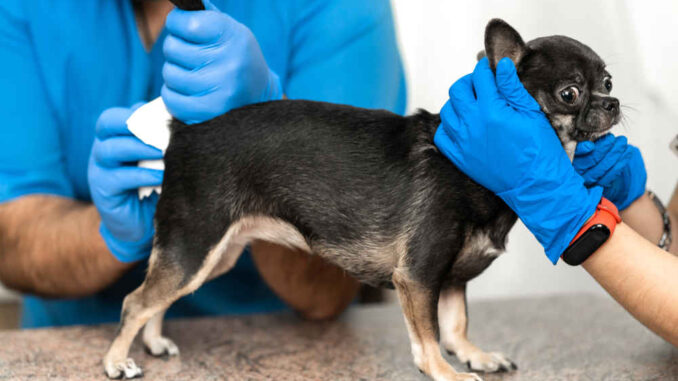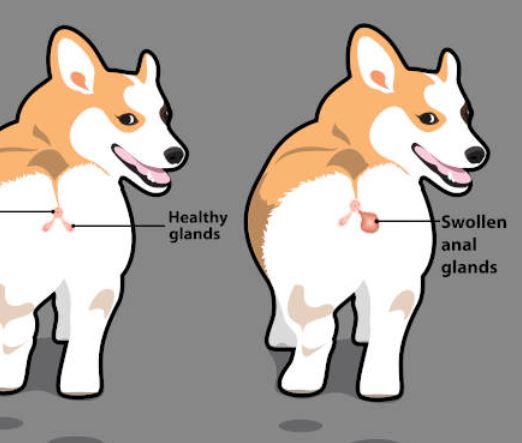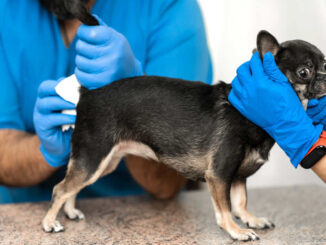
This article was updated on June 22nd, 2024

As an emergency veterinarian, I frequently see dogs being brought to the emergency room to investigate the causes of bleeding from their hind ends. While this is a complaint that is all too common for me, the sight of blood often frightens pet owners, and rightfully so. It hurts to see our furry friends uncomfortable or in pain.
4 most likely reasons for blood in your dog’s bottom
There could be a number of reasons causing bleeding, so it is important that you call your veterinarian to schedule an appointment as soon as possible. The most common causes include:
1. Hemorrhagic Diarrhea
Hemorrhagic diarrhea, also known as Acute Hemorrhagic Diarrhea Syndrome (AHDS), is a common cause of bleeding from a dog’s anus. The most common signs include:
- Large amounts of bloody diarrhea.
- Vomiting or anorexia.
- Increased urgency to go to the bathroom.
- Straining to defecate. Straining can cause worsening discomfort of the colon/anus, leading to more blood in the stool.
- A hallmark sign is diarrhea that looks like raspberry jam.
Diarrhea with blood can occur for a variety of underlying reasons, including dietary indiscretion (when your dog eats food outside of their regular diet), food intolerance, chronic gastrointestinal disease, parasitism, pancreatitis, stress, antibiotic use, and other systemic illnesses.
Learn more: My Dog Has Bloody Diarrhea.
2. Constipation
Opposite to the above, constipation is also a common cause of bleeding from the anus. Constipation is caused by the inability to defecate normally, either due to hard feces, disease of the rectum, anal obstructions, pain when defecating, or neurological/orthopedic disease.
Dogs that are constipated may strain to defecate with little to no production of feces. Bowel movements may be painful, and blood can be produced from breaking blood vessels in the rectum while straining. View our recommended home remedies to help mild cases of constipation (including increasing fluid intake and adding pumpkin to your dog’s diet).
3. Anal sac disease
Anal sac disease is relatively common in dogs, affecting approximately 1 out of 6 dogs during their lifetime. Dogs have two anal sacs situated on either side of their anus. These glands help with the lubrication of feces as well as scent marking during defecation. For a variety of reasons, these glands can become impacted or infected, as shown in the illustration below:

Common signs of anal sac disease include:
- Scooting or dragging their rear end on the ground
- Licking or biting at the anal area
- Swelling or redness around the anus
- Discharge or bleeding from the anal area
- Foul-smelling odor near the dog’s rear
Infected anal glands can also develop into abscesses which can rupture and bleed. Dogs may scoot, lick, or chew, leading to ulceration and bleeding of the perineal region.
Learn more: How to Tell If Your Dog’s Anal Glands Are Full
4. Perineal Fistulas
Perineal fistulas are caused by an auto-immune condition that leads to severe inflammation and ulceration of the perineal region. Dogs with this condition will develop tracts alongside the anus, which will often have foul-smelling discharge and can lead to bleeding, straining to defecate, and significant pain. German Shepherds are predisposed to this condition.
Mild recent cases of rectal bleeding rarely require urgent veterinary intervention.
However, dogs with signs of ongoing bloody diarrhea, pain, frank blood when defecating, vomiting, vomiting and diarrhea, or black/tarry stools require urgent veterinary intervention.
Waiting may lead to increased discomfort, pain, dehydration, and worsening of their overall condition (making it harder to treat your dog’s condition). Dogs with severe AHDS can become dehydrated quickly and even die from this illness, so it is important to call your vet if you see any signs of illness.
Call your vet if you see large amount of blood, pain, constipation and other signs of illness
Rectal bleeding is always concerning to pet owners but is not always an emergency. However, your dog requires urgent intervention if they display the the following clinical signs:
1. Defecating large amounts of blood: A small amount of blood in the stool can be seen with mild inflammation of the colon and is not overly concerning. But a large amount of blood or bright red blood in your dog’s poop is a sign of significant inflammation of the colon or damage to the local blood vessels. This should always be addressed by a veterinarian. Read this article if you can see blood in your dog’s poop, but your dog is acting normal.
2. Pain: A veterinarian should evaluate any dog that is showing signs of pain or discomfort as soon as possible.
3. Constipation: Dogs that cannot defecate for more than 24 or 48 hours require urgent intervention. Constipation can lead to significant discomfort, anorexia, and vomiting. Learn about remedies to help a constipated dog and when to call your vet.
4. Perineal fistulas: If you are concerned that your dog has a perineal fistula, urgent intervention is recommended. Catching the disease in its early phases will allow quicker diagnosis and treatment. This may halt the disease in the early phases leading to quicker relief for your pet and potentially a better response to therapy.
Perineal fistulas are an autoimmune condition that is very painful. These dogs need to see a veterinarian as soon as possible and may require lifelong treatment.
5. Other signs of illness. If your dog is showing any other signs of illness or discomfort, I recommend that you also see your veterinarian.
5 steps you can take at home to help your dog (in mild cases)
When meeting with your vet, you can discuss the following home remedies to find out if they can help your dog:
1. Diet change
Dogs with simple diarrhea with a small amount of blood may benefit from remedies at home. The easiest and most effective treatment an owner can provide is changing their dog’s meals to a bland diet. This diet typically consists of boiled chicken or lean ground beef mixed with white rice. An easily digestible diet may improve most cases of simple diarrhea after a day or two.
2. Fiber supplementation
Another simple over-the-counter solution to various causes of diarrhea and constipation includes the addition of fiber to the diet. Fiber supplements such as psyllium husk can improve fecal quality and texture. This can lead to improvements in diarrhea or decrease the likelihood of constipation.
3. Probiotics
An imbalance of bacteria in the gastrointestinal tract can cause bloody diarrhea. When bad bacteria outcompete the good, inflammation of the gastrointestinal tract can occur, leading to diarrhea. A simple solution is to provide canine-specific probiotics as a means of replenishing healthy bacteria and restoring gut health.
4. Preventative measures
The best way to prevent anal irritation and bleeding is to try to prevent diseases that cause it in the first place. This means avoiding food items that can cause upset stomachs leading to diarrhea. Monthly flea and tick preventatives will decrease the likelihood of diarrhea from gastrointestinal parasites.
5. Anal gland expression
Dogs who frequently experience anal gland problems benefit from routine anal gland expression. Scheduling expressions at your veterinary office can decrease the likelihood of impaction or abscess formation. Pumpkin and probiotics might help with a dog’s anal gland issues.
Before your veterinary visit, prepare a timeline of the clinical signs and take photos of any blood or feces. Additionally, bring a fresh fecal sample in case your vet needs to test for parasites or bacterial overgrowth.
How your veterinarian will diagnose the issue
- Your veterinarian will take a thorough history to help determine the cause of your dog’s anal bleeding.
- A physical and rectal exam will help determine if there are any abnormalities of the anus, anal glands, or stool.
- A fecal sample may be requested to evaluate for gastrointestinal parasites or overgrowth of bacteria.
- If the anal glands are abnormal, expression may be performed.
- In the event of an anal gland impaction or abscess, your dog may need to be sedated to have the anal sac drained.
Once a definitive diagnosis is made regarding the cause of your dog’s bleeding, your vet will discuss a targeted treatment plan. For example, this may include:
- medication or probiotics to improve diarrhea,
- pain medication, or deworming agents to eliminate gastrointestinal parasites.
- dogs with perineal fistulas may require treatments with immunosuppressive agents.
Learn more: Dog Has Red or Inflamed Anus: What to Do
Related posts:
Disclaimer: This website's content is not a substitute for veterinary care. Always consult with your veterinarian for healthcare decisions. Read More.









My dog is bleeding bad, an he is uncovertable can’t take him to doc.tell mornin help me
Hello there and I’m so sorry you are in this position. This is not an emergency service, you need to contact your local emergency clinic.
Bleeding from the back end can have a range of causes, the most likely will depend on your dog’s age, breed and medical history. It could be e.g. an infection, cancer, a ruptured abscess or recent toxicity.
As you say the bleeding is bad, he would be at risk of e.g. anaemia, shock and dehydration. So he does need vet care now. If cost is a concern, please discuss this with your vet who can try to keep costs down and may be able to signpost you to any local charity options.
His treatment is going to depend on what is going on and may include e.g. I.V. fluids, antibiotics and additional supportive care.
From home, we are quite limited in a case like this. Keep him warm and encourage rest. If he will take it, encourage water drinking and offer bland food like chicken and rice. As I say though, the sooner you can have him seen the better.
“The information on this website is not a substitute for in-person veterinary care. Always seek advice from your veterinarian if you have concerns about your pet’s medical condition.”